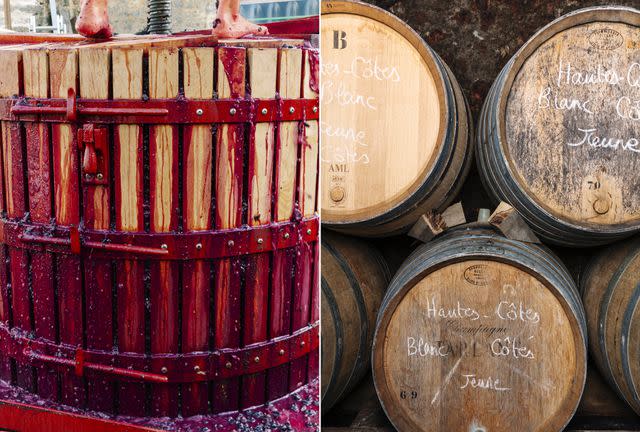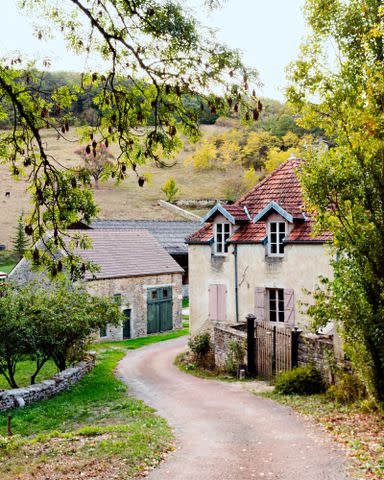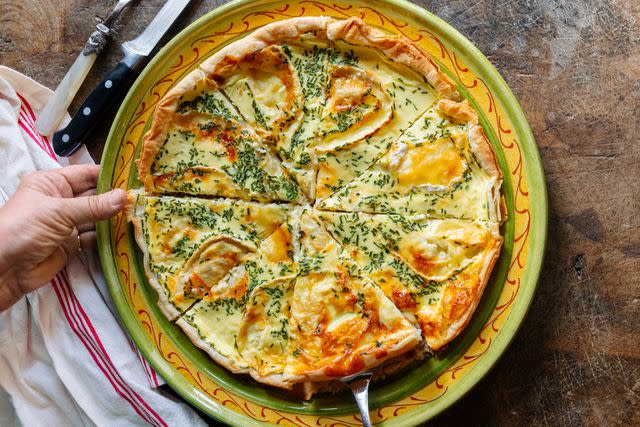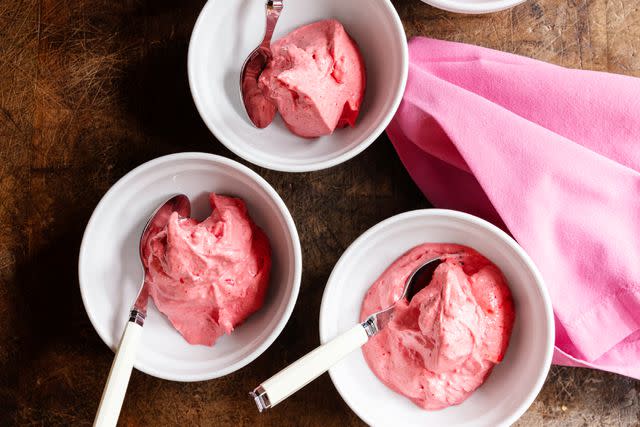Upstart Winemakers Are Shaking up One of France’s Most Iconic Wine Regions, With Superb Results
A new generation of winemakers is bringing a fresh sensibility to Burgundy.

Cedric Angeles
LEFT: Hugo Mathurin of Domaine de Cassiopée, in Maranges, Burgundy, holding grapes; RIGHT: The vines of Domaine Berthaut-Gerbet, in FixinEvery time the church bell in Sampigny-Lès-Maranges tolls the hour, Ratapoil starts singing. Ratapoil is Talloulah Dubourg and Hugo Mathurin’s black Labrador, and his response to the bell, even down in Domaine de Cassiopée’s small basement cellar, is a kind of operatic ululation, gorgeous albeit slightly eerie. “He’s named for this estate we like in Jura,” Mathurin explains. “Their wines are totally bizarre, but when you get a good one, they’re delicious.” Ratapoil, done with singing and uninterested in the origins of his name, comes and sits on my foot.
Dubourg and Mathurin are the young owners of Domaine de Cassiopée, which they founded in 2020. I was visiting them not just because their wines are lovely, but because they’re representative of a new generation of Burgundy producers who are shaking up a place that doesn’t necessarily love being shaken. Most of them are young, most farm organically or biodynamically, most lean toward less intrusive styles of winemaking — native rather than manufactured yeasts, less new oak, lower sulfur levels — and almost all of them can be found in appellations like Maranges, which carries nowhere near the cachet of places like Vosne-Romanée or Gevrey-Chambertin.
Related: How to Find the Best Wines From Burgundy
What Maranges does have is land that someone who is not a billionaire can afford. Dubourg and Mathurin have both worked at star properties — she at the grand cru Clos de Tart and he at Domaine Roulot and Domaine Jacques-Frédéric Mugnier — but their 12 acres here are a more humble venture. Even so, they were lucky to get it. They bought the property from a Dane who’d taken an unsuccessful stab at making wine, then decided to move back to Denmark. “He hadn’t listed it online, and if he had, everyone in Burgundy would have been here in two days,” Dubourg told me. “But he was happy, he told us, to sell to young winemakers who wanted to have a family here.” That’s part of their plan as well. The name Domaine de Cassiopée, after the constellation Cassiopeia, nods toward their philosophy but also their future as a family. “We work a lot with the moon and with biodynamics, so it felt right,” Dubourg told me. “And Cassiopée is also what we’ll name the daughter we hope to have someday.”

Cedric Angeles
Vineyards in the village of MeursaultA call back to OG Burgundy
In many ways, this new Burgundy feels like the Burgundy of long ago, when the place was still a region of small, family-owned, unpretentious domaines, the less polished counterweight to the grand châteaus of Bordeaux; the Burgundy before wines like Armand Rousseau Chambertin and Roumier Les Amoureuses started selling for $5,000 or more. These newer Burgundian producers out on the fringes tend to operate more like a start-up restaurant — you may be the chef, or in this case the winemaker, but you’re also the accountant, the farmer, the plumber, the forklift driver, the contract negotiator, and the head bottle-washer, not to mention often a parent as well. Fancy isn’t the focus. When I stopped later that day to visit Vincent Chevrot of Domaine Chevrot, also in Maranges, he was wearing sunglasses, a black Monkey Bizness Skate Wear T-shirt, and shorts, and he was standing next to the pingpong table he and his brother, Pablo, keep on the winery’s crush pad. “It’s good for team-building!” he said.
Domaine Chevrot’s history is longer than Cassiopée’s, in that the Chevrot family has farmed here since the 1800s. Like many families, for decades they sold their wine to large négociant firms. “But our generation is different,” Vincent told me. “We don’t want our wines to disappear into some big company’s barrels.” (Nor should they: It would be sad if their impressively seductive Maranges Sur le Chêne existed solely to bulk up some négociant’s Bourgogne rouge.)
Like the wines of Maranges, those of Fixin, just north of Gevrey-Chambertin as you head toward Dijon, long had a reputation of being hard and unsubtle; fine for blending, not so exciting on their own. “People still say this about Fixin’s wines, that they’re ‘rustic,’” Amélie Berthaut, of Domaine Berthaut-Gerbet, told me as she poured me one of her wines in the cellar underneath her family’s house. “And it’s true that in the past the reputation was for rustic tannins, for huge wines. But that was the winemaking they were doing at the time: machine harvesting, lots of extraction. We’ve changed all that.” Berthaut took over her family’s domaine in 2013, when she was only 25, despite an early inclination to have nothing to do with it: “I saw my parents working so hard all the time, and I didn’t want that. As a child, we never saw them, unless we wanted to work with them. When I was in school, I used to do my homework on the barrelheads in chalk.” Even so, wine won out, and like the Chevrot brothers, she’s brought a fresh sensibility and approach to the Berthaut-Gerbet wines. Her Fixin rouge, to take one example, is all crunchy red fruit, fresh and bright — a far cry from “rustic.” And her complex, layered premier cru Fixin Les Arvelets fully supports her when she says, “Les Arvelets is a great vineyard. It’s only Fixin, not a famous appellation. But it’s better than many more-famous vineyards.”
In my swoop through the less acclaimed locales of Burgundy, I visited almost two dozen up-and-coming domaines that were all making stellar wines. (Many of them are profiled in my new book, The World in a Wineglass, which is a look at producers like these all over the world.) In the tiny town of Meloisey, in the Hautes Côtes de Beaune, Agnès Paquet makes alluringly transparent reds and whites that completely defy old expectations of what the cold valleys of the Hautes Côtes could produce. “It’s a strange thing, but with climate change, we can make ripe enough wines here now,” she told me. “As a result, people have become interested. But then, I’ve always made wine in non-famous appellations. When I started, no one knew Auxey-Duresses, either. They didn’t even know how to pronounce it. ‘Do you say “osay” or “oxay”?’ Well, the most important thing is to talk about it in the first place!” (It’s “osay.”)

Cedric Angeles
LEFT: Pressing grapes at Domaine Dandelion; RIGHT: Aging wine at Domaine de CassiopéNatural is the new (and old) normal
A couple miles down the road from Paquet, Morgane Seuillot and Christian Knott of Domaine Dandelion organically farm a little under 10 acres of vines, working with horses as much as possible. (The horses, Safran and Reine, were Seuillot’s father’s team until he passed away in 2022.) “The soil is definitely less compacted if you use horses,” Seuillot said, as we tasted the wines at her and Knott’s kitchen table. “If you stick your hand in the ground, it’s soft and fluffy, not dense and hard.”
Ironically, the older generation in the Hautes Côtes is the one accustomed to farming with herbicides and chemical fertilizers, often regarding organic and biodynamic practices with some suspicion. Seuillot grows favas and peas for ground cover between her vines, which help with the soil’s nitrogen content. But even though she grew up in Meloisey, they’ve also gotten her a derisory comment or two: Pff, Morgane et ses petits pois! (“Morgane and her peas!”) She laughed, recalling this: “They definitely see that our vineyards look different.”
No one ever said organic farming was easy. Sometimes, the old guys in town make fun of your legumes; sometimes, your Pinot Noir grapes get eaten by badgers. The latter came up when I was in Savigny-lès-Beaune at Chanterêves, the acclaimed micro-négociant (and now domaine) founded by husband-and-wife winemakers Guillaume Bott and Tomoko Kuriyama in 2010. Unlike traditional négociants, who often purchase finished wine, Kuriyama and Bott bought grapes from like-minded farmers and made their wines themselves, working in a low-intervention style without quite heading into the wilds of natural-wine land. “We make wines we want to drink,” Kuriyama told me, and however you choose to classify them, the Chanterêves wines are hauntingly expressive and graceful.
Related: Natural Wine 101: An Explainer on Low-Intervention Wine
In 2020, they finally managed to purchase land of their own, a triumph that came with its own problems. Kuriyama poured me some of their aromatic, blue-fruited Savigny-lès-Beaune Dessus de Montchenevoy red, which comes from a tiny parcel of vines they own at the top of the appellation. “It’s very isolated,” Kuriyama said. “And we have to fence it because otherwise, badgers come and eat the grapes. They’re very determined.”

Cedric Angeles
A village landscapeA taste of history
We tend to think of the reputations of wine regions, particularly in places like Burgundy, with its established hierarchy of grands crus, premiers crus, and village wines, as being carved in stone — or at least written in the terroir under our feet. But reputations are just as often affected by the caprices of history. Like Maranges or Meloisey, Givry, in southern Burgundy’s Côte Chalonnaise, is not usually mentioned in the same breath as Chambolle-Musigny or Vosne-Romanée, to pick a couple of Burgundy’s great villages. The last time it might have had equal fame was when its wines were, it’s said, the favorites of the French king Henri IV. Given that that was around 1600 or so, it’s been a while. But as Philippe Pascal, owner of Domaine du Cellier aux Moines in Givry, says, “There are great terroirs here in the Côte Chalonnaise, comparable to what you find in the Côte de Beaune and Côte de Nuits. The difference here is that after phylloxera and World War I, we also had the emergence of the steel industry. At the time, the wine business was challenging. Many men left the vineyards and went to the mills, so for 50 years, the Côte Chalonnaise vineyards lagged behind — less investment, less replanting. Since the 1970s, we’ve been catching up, but it takes time to come back.”
It took Philippe over a decade to find Cellier aux Moines, and when he did, it was in terrible condition, the buildings collapsing and the vineyard in disrepair. He and his wife, Catherine, spent five years renovating the property. Today, the house they live in is beautifully restored, its stone terrace looking over the gently sloping vineyards down to the town of Givry. It abuts the monks’ original cellar. As we stood there in that cellar, in the cool, stony semidarkness, he said, “This was built circa 1130, and then the monks kept expanding it until 1750 or so. Then in 1789, of course, the revolutionary government threw them out.” A huge grape press, made by the monks from towering oak trees from the nearby forest, still occupies a large part of the space.
The massiveness of that press — the main horizontal beam weighs three tons — felt substantially at odds with the lightness of the lunch that Catherine made for us later: a savory quiche; poulet en croûte; and a fresh green salad. As we ate, we sat on the terrace, enjoying glasses of the fragrant Domaine du Cellier aux Moines Montagny Les Combes Premier Cru white. Philippe said, “The monks in Burgundy always picked very special places to make wine, and when we saw this place, even though it was falling to pieces, we could feel the emotion behind it.” In his 60s now, Philippe is older than many of the outlier Burgundian vintners I’d been visiting — this is his second career — but his winemaker, Guillaume Marko, is in his thirties, and together, they work in the same way: biodynamic farming, native yeasts, wines that refuse to compromise in any way the character of the place they spring from. He added thoughtfully, “When you’re at a point in your life where you’re looking for meaning in what you do, when you see a place that has so much history, that you feel has a spirit that’s special, that’s a place where you could spend the last chapter of your life.”
Later, as we sat drinking some extremely old Chartreuse and spooning up bites of Catherine’s absurdly simple and delicious strawberry sorbet, he said, “Cellier aux Moines — ‘cellar of the monks.’ Maybe it’s a terrible name, but we’re hardly going to change it now. They were Cistercian monks who settled on the hill here, in this house — the same monks who a few years before planted Clos Vougeot. Fine, then. Givry may not be as famous as Vougeot, but we do have just as much history!”

Cedric Angeles
Cellier aux MoinesWhere to eat, drink, and stay in Burgundy
Where to taste
The wineries I’ve written about here are small and are generally not open to the public, at least not in the way we think of wineries in, say, Napa Valley. (These smaller producers simply don’t have the staff to run a tasting room.) The best way to visit is to hire a good tour company. For both up-and-coming and established Burgundy domaines, there’s no one better than Loïc Lamy of Hautes Côtes. He’s a terrific raconteur and translator and is close friends with many of the producers in this story; plus, he makes a small amount of excellent wine himself with his micro-négociant Vins Saisons project.
Where to stay
The Hôtel de la Poste in central Beaune is both affordable and incredibly convenient. What it lacks in luxury it makes up for in charm; staying here certainly makes you feel you’re in France, and possibly in a slightly earlier, calmer era of France. Rooms from $119
If you’d rather skip the city and stay out among the vineyards, head to the Olivier Leflaive Hôtel in Puligny-Montrachet, owned by the wine producer of the same name. It’s elegantly appointed, it’s in the heart of the Côte d’Or, and the restaurant on-site is excellent. Rooms from $193
Where to eat
Boulangerie Gagnepain Pierre-André Gagnepain makes — no exaggeration — some of the best croissants you will ever have at his bakery in the Hautes Côtes de Beaune, in the tiny town of Mavilly-Mandelot. The hitch is that he’s open only for one hour most mornings, and locals buy out his production regularly. Plan in advance. 2 Grande Rue, Mavilly-Mandelot
Refined French country cooking with ultra-fresh ingredients — and a well-chosen and well-priced wine list — is the story at this charming spot in the small town of Curtil-Vergy.
Caves Madeleine
Easily one of the best and most charming restaurants in Beaune, Caves Madeleine is a destination for local winemakers, who come for chef-owner Martial Blanchon’s locally sourced food and extensive (700-plus selections) wine list, which is filled with bottles from producers that are hard to track down.
This is the perfect place to stop for lunch in Meursault if you have a designated driver because there is zero chance you will walk out without having drunk your share of wine from the vast and affordable wine list. Chef Jérémy Pezé’s prix-fixe menu leans toward wine-friendly dishes.
Brie Quiche

Cedric Angeles
Creamy Brie cheese is the secret to this rich, custardy quiche.
Poulet en Croûte

Cedric Angeles
This chicken pot pie is a simple, comforting one-dish meal perfect for a brisk, wintry day to warm you from the inside out.
Roasted Strawberry Sorbet

Cedric Angeles
Roasted strawberries and Pinot Noir give intense fruit flavors to this silky, juicy sorbet.
For more Food & Wine news, make sure to sign up for our newsletter!
Read the original article on Food & Wine.


